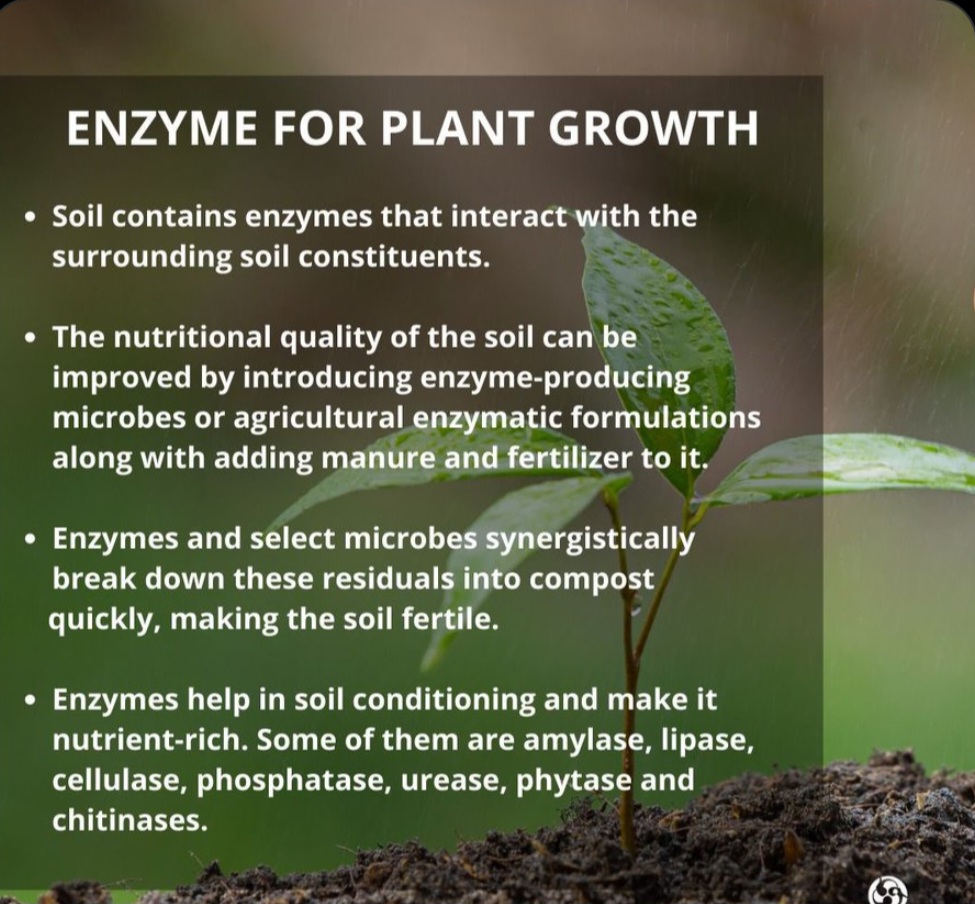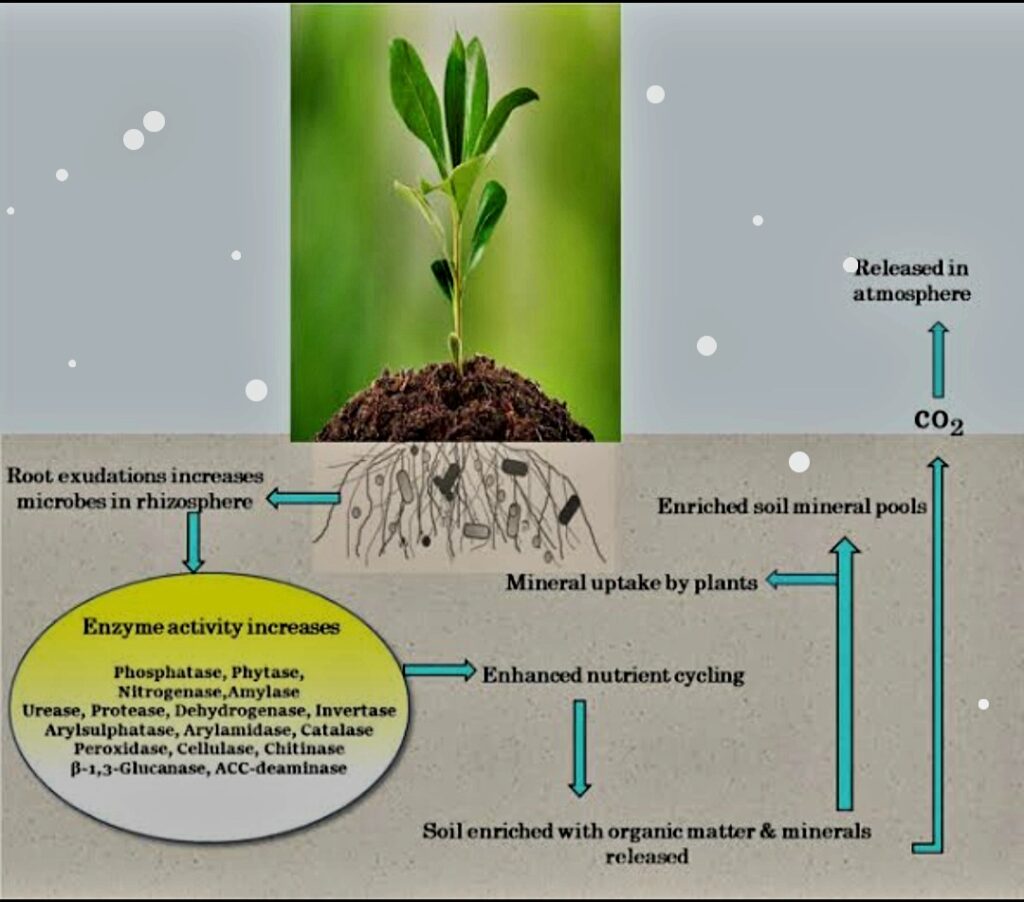
Soil is the home for many organisms, place where different activities necessary for life of organisms occur. Plants grow on soil; microorganisms live in soils; water is found in and flow on soil; animals spend their life and move on soil; food for human and animals are grown on and in soil; nutrients required by plants and nutrient cycles are mined and take place in soils respectively. Also, humans establish and build their residence and building structures necessary for their livelihood on soils. Therefore, soils play major roles in the survival of all organisms on earth.
With all these beneficial importance of soil, soil can also be abused especially through human activities. For example, soil had been seen as a medium for disposal of hazardous wastes which may have a latter effect on human health and other organisms. Some other human activities like deforestation had lead to desertification, erosion, runoff, flooding, deficit or even loss of biodiversity, alteration of the soil matrix, deficiency of organic matter and nutrients losses through leaching etc. All of these have consequences on soil health and productivity, and balance in soil life.
For a soil to be considered healthy, productive and functional, the soil biological, biochemical, physical and chemical properties, all must correlated to give a balanced environment which will be able to sustain all activities occurring in it. One way this can be achieved is through the role of soil enzymes in the soil.
Soil enzymes are biocatalyst mostly proteinaceous in nature. They are also refered to as nature catalyst. They speed up the biochemical reactions and support the very existence of life on earth.
Soil enzymes play a fundamental role within the soil. It plays a key role in the energy transfer through decomposition of soil organic matter and nutrient cycling and hence play an important role in agriculture. They mediate numerous chemical reactions involved in soil nutrient cycling; transformation of plant and microbes’ debris; mineralisation and transformation of organic matter within the carbon cycle; transformation and degradation of potentially hazardous pollutants; thus contributing to the restoration and remediation of polluted soils. Also, soil enzymes are the important moderator and catalysts which play significant roles in soil. Soil enzymes such as invertase, urease, phosphatase, arylsulfatase, and hydrolase play an essential role in nutrient cycling. They catalyse the cycling of nutrients such as carbon (C), nitrogen (N), phosphate (P), and sulphur (S) also organic matter (OM) decomposition in soils .
Soil enzymes are a group of enzymes whose usual inhabitants are the soil and are continously playing an important role in maintaining soil ecology , physical and chemical properties, fertility and soil health.
All these makes soil enzymes an important factor involved in all activities fundamental to agricultural production and also used as useful indicators of microbial nutrient demand and soil health and quality.
IMPORTANCE OF SOIL ENZYMES
Enzymes trigger trillions of catalyst reactions in the soil. They are important for the following:
1. They release nutrients in soil by means of organic matter degradation
2. They are used for identification of soil
3. They are used for identification of microbial activities.
4. Enzymes enhance plant growth
5. They improve nutrient uptake
6. They strengthen plant defense mechanisms.
7. They can be applied as seed treatments, foliage sprays, or soil ammendments to provide healthier and more productive crops.
8. They play major role in impacting soil health, plant quality and agricultural productivity.
9. Some enzymes only facilitate the breakdown of organic matter (e.g. hydrolase, glucosidase), while others are involved in nutrient mineralisation (e.g. amidase, urease, phosphatase, sulphates).
10. Enzymes respond to soil management changes long before other soil quality indicator changes are detectable.
11. The activity of enzymes can be used to discover the level of pollution in soil (such as heavy metals, SO4),
12. Enzymes activities can be used to assess the successional stages, and degrade pesticides in the soil environment
13. Soil enzyme activity can be used as an essential soil-quality indicator.
MECHANISMS OF ENZYMES
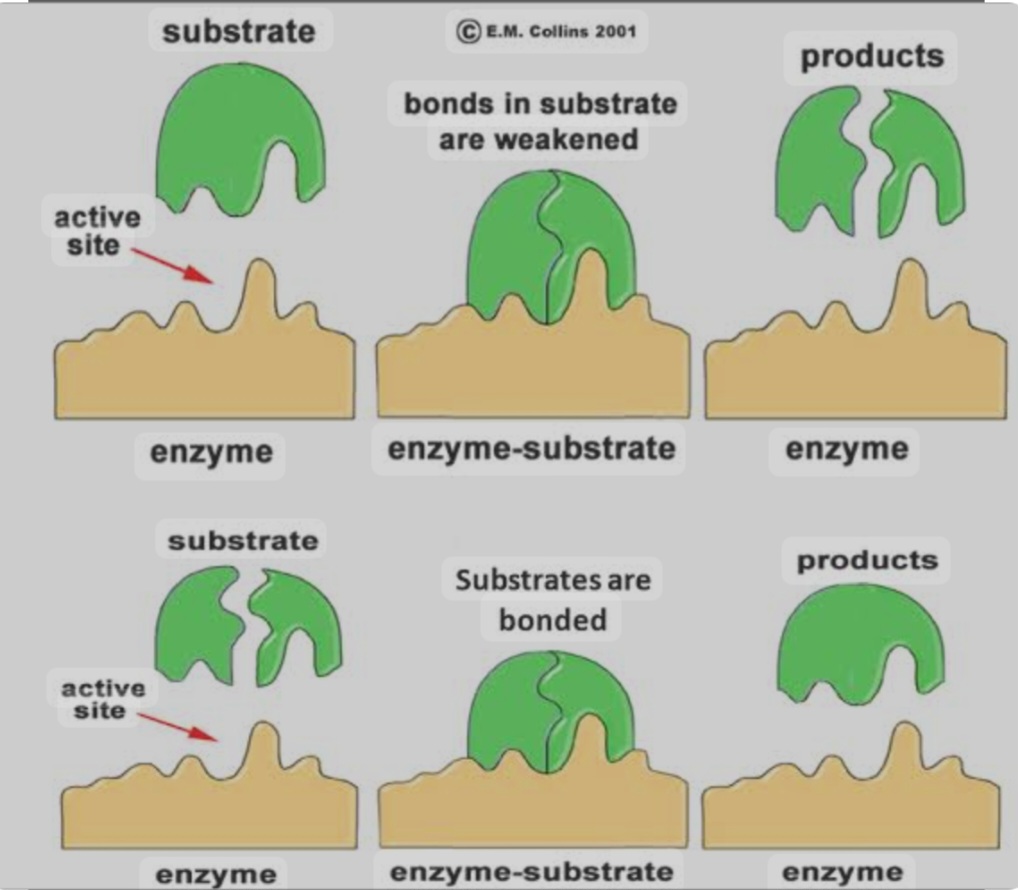
FUNCTIONS OF SOIL ENZYMES
1. They increase the reaction rate at which plant residues decompose and release plant available nutrients.
2. Enzymes are specific to a substrate and have active sites that bind to a substrate to form a temporarily complex . The substance acted upon by a soil enzyme is called the substrate. For example, glucosidase (soil enzyme) cleaves glucose from glucoside (substrate), a compound common in plants.
3. Enzymatic reactions usually release a product which are nutrients contained in the substrate.
4. They mobilize soil nutrients. For example, improves availability of plant nutrients from fertilizers to plants and soil microbs
5. They help break down crop residues which result to more carbon in the soil and increase microbial activities in the soil.
6. Enzymes improves plant defence mechanisms:
7. In agriculture, enzymes are organic fertilizers
8. They act as natural herbicides, pesticides and fertilizers that help the plant or crop to reach its best possible growth and yield
9. Enzymes are usually added to fodder of livestock, to help the animals with their proper digestive functions and aids.
10. Enzymes are specific to a substrate and have active sites that bind with the substrate to form a temporary complex. The enzymatic reaction releases a product, which can be a nutrient contained in the substrate.
ORIGIN OF SOIL ENZYMES
Enzymes are specialized proteins produced by the following organisms:
- Microorganisms either living or dead
- Plant roots and plant residues
- Soil animals.
They are biological catalyst that accelerate chemical reactions without them being consumed in the process.
CLASSIFICATION OF SOIL ENZYMES
There are about 5000 known enzymes in the world.
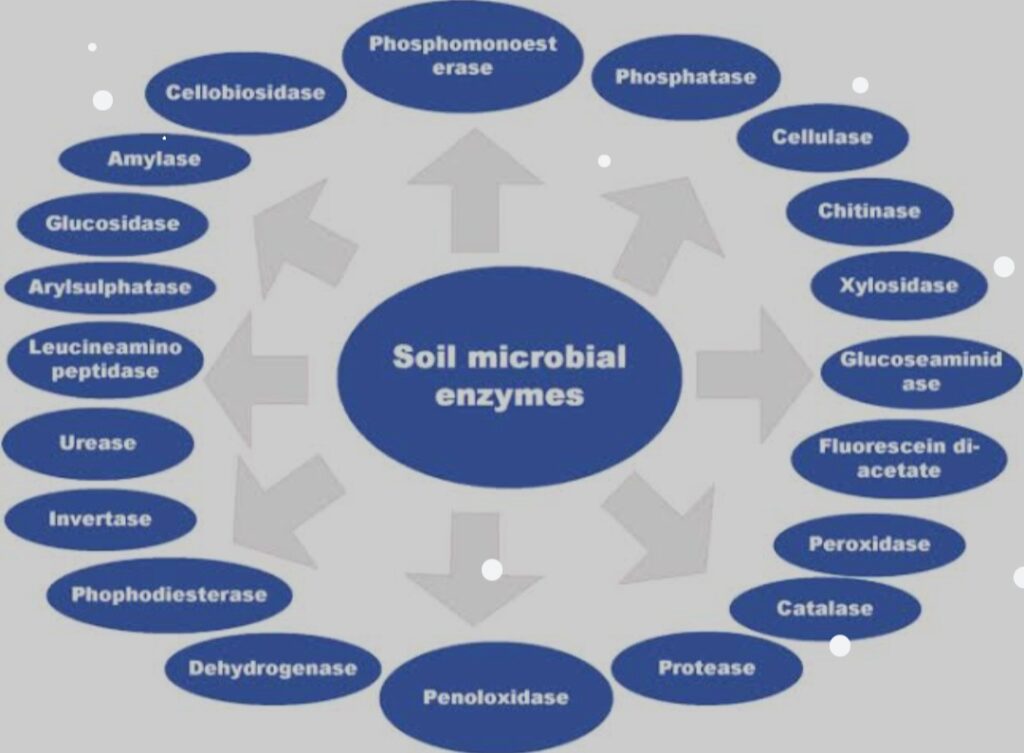
1. Based on their action, there are six main classes of soil enzymes. They include:
a. OXYDOREDUCTASE: Oxidation reduction reaction. It involve the transfer of electrons (hydride ions or hydrogen atoms). For example, dehydrogenase, catalase, Peroxidase.
b. TRANSFERASES: Transfer of groups of atoms from donor to an acceptor molecules. for example, Aminotransferases, Rhodonese.
c. HYDROLASES: It involve hyrolysis reaction ( that is, transfer of functional groups of water ). Hydrologic cleavage of bonds. for example phosphates, cellulose and Urease.
d. LYASES: Cleavage of C-C, C-O, C-N bonds other than hydrolysis or oxidation. It eliminate groups leaving double bonds or addition of grous to the double bonds. for example, Aldolase.
e. ISOMERASES; Isomerization reaction. It involves the transfer of groups within molecules to yield isometric forms.
f. LIGASES: Formation of bonds by the cleavage of ATP. for example Acetyl-CoA carboxylases. The bonds are formed by condensation reaction coupled to cleavage to the ATP or similar cofactor.
2. CLASSIFICATION BASED ON WHEN THE ENZYMES ARE PRODUCED IN A BIOLOGICAL SYSTEM
a. CONSTITUTIVE ENZYMES: These are enzymes present in nearly constant amount in a cell ( these are not affected by additon of any particular substrate and the genes encoding then are always expressed. for example, Pyrophosphatase.
b. INDUCIBLE ENZYME: These enzymes are present only in trace amount or not at all. But they quickly increase their concentration when the substrates are present. For example, Amidase.
Both constitutive and inducible enzymes are present in the soil
3. ENZYMES CAN ALSO BE CLASSIFIED BASED ON THEIR pH OPTIMA AND VARIATION WITH SOIL pH
GroupA: Acidic consistent among soils
ENZYMES: cellobiohydrolase SOIL pH: 4.0-4.5
ENZYMES: β-xylanase SOIL pH:4.5-5.5
ENZYMES: arylsulphatase SOIL pH:3.0
GROUPB; Acidic – sub-acidic, variable with soil pH
ENZYMES: α-glucosidase. SOIL pH:3.0-7.0
ENZYMES: β -glucosidase. SOIL pH:3.0-4.75
ENZYMES: β- N-acetylglucosaminidase SOIL pH:3.0-5.0
GROUPC; Acidic or alkaline, depending on soil pH
ENZYMES: acid phosphomonoesterase SOIL pH:3.0-5.0
ENZYMES: alkaline phosphomonoesterase
SOIL pH:9.5-11.5
ENZYMES: phosphodiesterase SOIL pH:3.0-5.5
STATES OF ENZYMES IN SOILS
Enzymes stabilised in the soil matrix accumulate or form complexes with organic matter (humus), clay, and humus-clay complexes
1. Role of clays. 2. Role of organic matter. 3. Role of clay-organic matter complex. 1.ROLE OF CLAY:
a. Enzymes are involved in most activities associated with clay.
b. They increase resistance to proteolysis and microbial attack
c. They also increases the temperature of inactivation
2. ROLE OF ORGANIC MATTER
a. Humus materials provides stability to soil Nitrogen compounds
b. enzymes attached to insoluble organic matrices exhibit plant and temperature changes
3. ROLE OF ORGANIC MATTER-CLAY COMPLEX
a. lignin + bentonite ( clay) protect enzymes against proteiolitic attack but not bentonite alone.
b. Enzymes are bound ro organic matter which is then bound to clay
CRUCIAL ROLES OF ENZYMES
1. Enzymes and nitrogen fixation
2.Enzymes and soil health. 3. Enzymes and plant defence mechanisms. 4. Enzymes and nutrient release

1. ENZYMES IN NITROGEN FIXATION
Enzymes play a crucial role in fixing Nitrogen into the soil. Nitrogen fixing enzymes produced by certain bacteria and legumineous plants, convert atmospheric nitrogen into a usable form for plant uptake. This process significantly contribute to soil fertility and reduces the need for synthetic nitrogen fertilizers.
2. ENZYMES AND SOIL HEALTH
Enzymes Contribute to soil health and soil fertility. They participate in organic matter decompostion. They accelerate the break down of crop residues and other plant materials. The decomposition process releases nutrient back into the soil and exchange it with vital elements for future plant growth.
3. ENZYMES AND PLANT DEFENCE MECHANISMS
When plants are attacked by pests and diseases, they produce defence related enzymes that counteract the damage caused. The enzymes help break down harmful substances, strengthen cell walls and trigger defensive responsiveness. It enhance the plants ability to respond and withstand stress.
4. ENZYMES AND NUTRIENT RELEASE
Enzymes help in the break down and release of nutrients from organic matter. Enzymes like cellulose, protease and amylase help break down complex molecules such as cellulose, proteins and starch respectively into simpler forms that plants can readily absorb and utilize.
SYSTEMATIC NAMING OF ENZYMES
Enzymes are named by adding the suffix “-ase” at the end of the substrate name.
For example, Lactase act on the substrate lactose
Lactose galactohydrolase (EC 3.2.1.190)
EC number: All enzymes are assigned an EC (Enzyme commission) number. It is defined as which reaction is catalyzed by the enzyme
Trypsin-EC3.4.21.5
3: describe the enzyme class (hydrolase)-hydrolysis reaction.
4: this is for the subclass ( acts on peptide bonds).So it is a peptide hydrolase
21: this denote its sub-subclass as a serine peptide
5: this denote the forth entry in the subclass
ENVIRONMENTAL FACTORS AFFECTING PRODUCTION AND EXPRESSION OF SOIL ENZYME ACTIVITIES
Soil enzyme activities may be affected by numerous factors of both natural (i.e. physio-geological, geographical or physic-chemical properties of soils, organic, clay or biomass contents etc.) and anthropogenic (agricultural management, environmental pollution, additives such as fertilisers, pesticides, salts, heavy metals, etc.) nature. These factors may influence the production, activity, catalytic behaviour and persistence of soil enzymes through different mechanisms involving direct, either reversible or irreversible, and indirect effects. Reversible or irreversible action on the catalytic active site of soil enzymatic activities as well as alteration of the protein conformation may occur.
CLIMATE: Climate can significantly affect the soil enzyme activity because soil enzymes are sensitive to temperature and precipitation. Studies have shown that at harsh climatic condition areas, the areas are characterized with less waste input, lower decomposability of organic residues, and reduced numbers of microorganisms and enzyme activity.
Both the production and turnover rates of enzymes are affected by temperature and moisture content; hence affected by season and climate change.
Temperature and moisture can affect both the overall rate of enzyme production and the relative quality of production of different enzymes because they influence enzyme efficiency, substrate availability, and microbial efficiency.
In addition, heat and extreme cold can alter the enzyme structure and substrate binding. Enzyme Activities decrease above and below optimum temperature.
SOIL pH: Most enzymes are sensitive to pH. They have a specific pH range and optimum pH of activity. Soil pH has substantial effects on the structure and diversity of soil bacterial communities, and a suitable pH can benefit microbial growth. thus, increasing the rate of residue decomposition and enzyme activities.
Soil enzyme function at varying pH values. For example, variation in pH do affect the activities of phosphatase, arylsulfatase, and amidase which are involved in phosphorus, sulfur and nitrogen cycle.
HEAVY METALS: Heavy metal pollution is a serious global environmental problem as it contributes to ecological disturbances. Toxic metals cause enzyme inactivation leading to changes in soil characteristics, limiting the productiveness and environmental functions. When materials containing heavy metals are added to the soil, they reduce enzyme activities due to their toxic effect on soil organisms and plant roots or they directly inhibit enzyme activities.
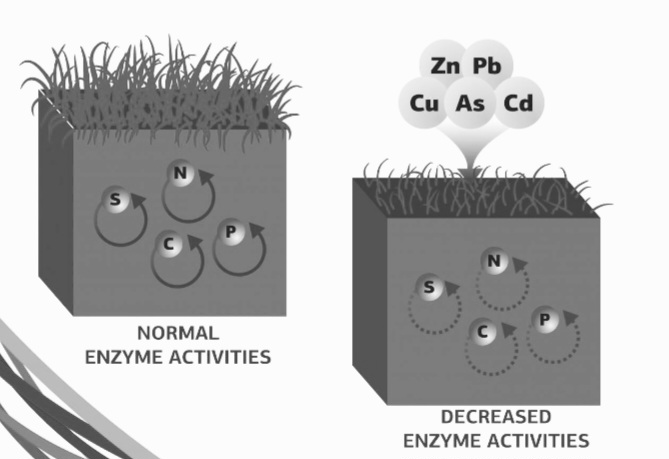
SOIL MOISTURE CONTENT: Activities of many enzymes are correlated with soil moisture content. for example, drought may suppress enzyme activities in drought prone areas.
SOIL TEXTURE: Soil texture have great effect on enzyme activities. for example, Clayey soils have greater ability to store organic matter that enhance microbial communities and clay from clay -enzyme complex. Sandy soil on the other hand exhibit low rate of enzyme activities because sandy soils are low in organic matter content and have low water holding capacity which makes it low in microbial biomas and therefore, low in enzyme activities
ORGANIC AMMENDMENTS: Application of organic ammendments coupled with good management practices increases soil organic matter which also result in increase in enzyme activities in the soil. Plant roots do stimulate enzymes activities because they bring about a positive effect in microbial activities and production of exhudates rich in substrates which are acted on by enzymes.
CHEMICAL COMPOUNDS: An increase in concentration of soil chemical compounds that are end products of enzymatic reactions can inhibit enzymatic activities by feedback inhibition. For example, phosphatase activities do increase in phosphorus deficient soils, and vice versa. Similarly, Urease activities may be suppresses by ammonia based nitrogen fertilizers because ammonium is the product of urease activities.
SOIL COMPACTION: Soil compaction do limit the activities of enzymes involved in nutrient mineralisation in soils because compaction result in reduction in soil oxygen which is required by soil aerobic organisms or reactions that require oxygen to activate. In contrast, anaerobic condition from compaction or water saturation increases enzymatic reaction rate related to denitrification.
EFFECTS OF ABSENT OF SOIL ENZYMES IN SOILS
Absent or suppression of soil enzymes in soils result in prevention or reduction in processes that affect plant nutrition. Poor enzyme activities for example, low pesticide or organic matter degradation enzymes can result in accumulation of harmful chemicals in the environment or accumulation of crop residues on top of the top soil layer. These harmful chemicals may therefore inhibit enzyme activities in the soil.
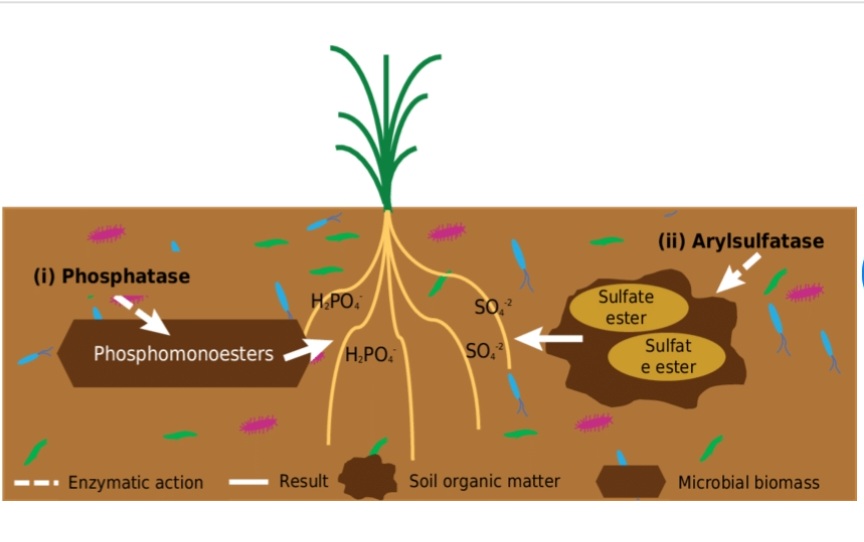
METHODS USED TO IMPROVE ENZYME AMOUNT AND ACTIVITIES IN THE SOIL
a. Crop rotation practices
b. Use of cover crops
c. Application of organic ammendments
d. Pasture helps in reducing soil disturbance and input animal manure in the soil
e. Liming to increase soil pH
HOW TO MEASURE SOIL ENZYMES
Soil enzymes are measured and determined in the laboratory using biochemical assey. The spectrophotometer, fume hood, centrifuge and or shaker, pH meter and thermometer are equipments used to determine or measure the amount of enzyme present in a soil.
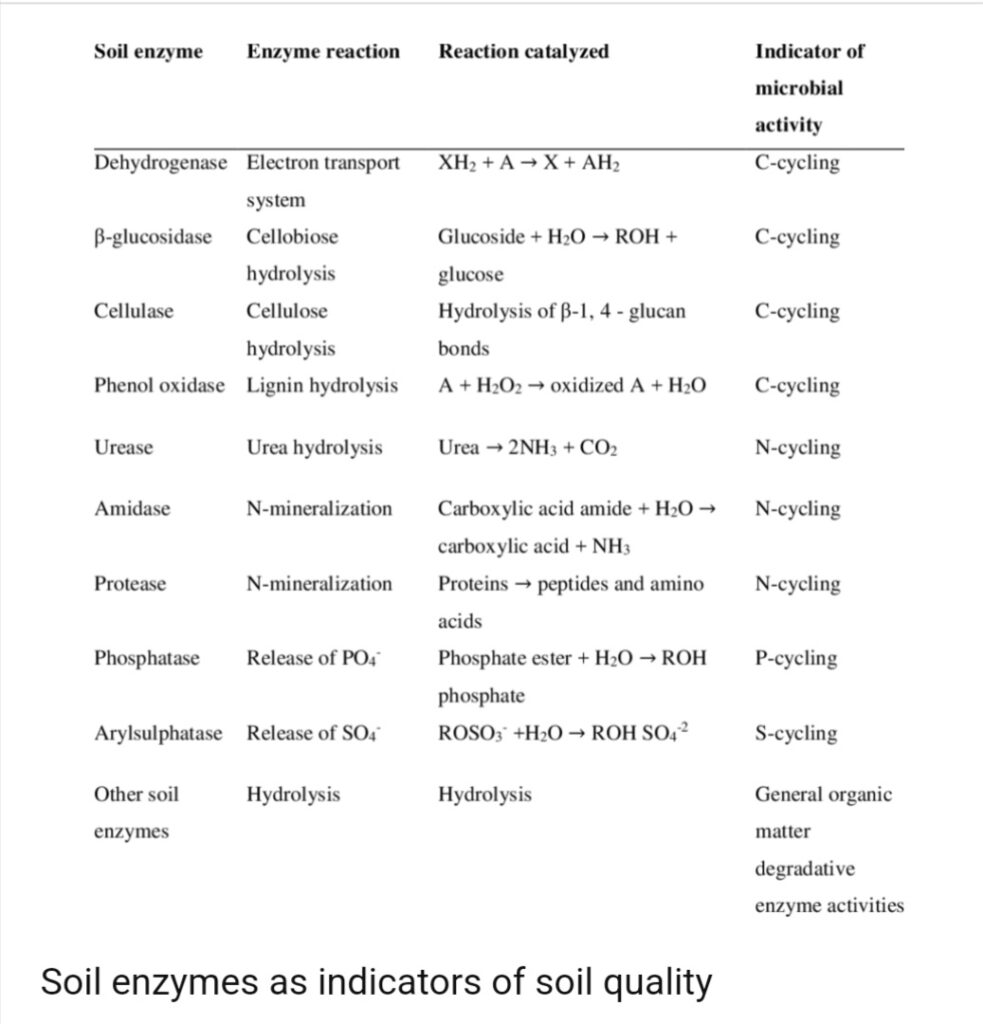
In conclusion, Biochemical, chemical and physiochemical reactions that brings about the soil system and nutrient cycles are being mediated by soil microbs which employ several enzymes to complete the vital reactions. Enzymes are crucial catalysts needed in agricultural production. Farmers can promote sustainable farming practices, reduce reliance on synthetic inputs, enhance agricultural productivity and improve soil health and fertility by incorporating and understanding the relevance of enzymes as soil ammendments and other uses.
